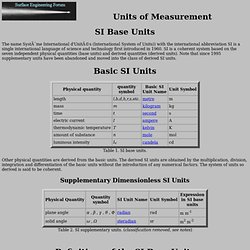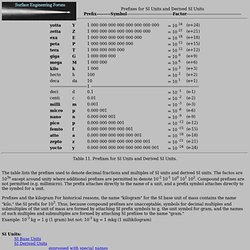

Measurement Worksheets and Measurement Games, Length, weight, capacity facts and online practice. Metric 4 US - Metric is the better system for America! Metric 4 US - Why Metric is the Better System. Free printable measuring units worksheets from Homeschool Math. SI Base Units. The name Système International d'Unités (International System of Units)) with the international abbreviation SI is a single international language of science and technology first introduced in 1960.

SI is a coherent system based on the seven independent physical quantities (base units) and derived quantities (derived units). Note that since 1995 supplementary units have been abandoned and moved into the class of derived SI units. Table 1. SI base units. Other physical quantities are derived from the basic units. Supplementary Dimensionless SI Units Table 2. Length: metre (m) The metre is the length of the path travelled by light in vacuum during a time interval of 1/299 792 458 of a second. Mass: kilogram (kg) The kilogram is equal to the mass of the international prototype of the kilogram: a piece of platinum-iridium alloy kept at the International Bureau of Weights and Measures, Sévres, France. Time: second (s) Electric current: ampere (A) Thermodynamic temperature: kelvin (K) SI Unit Prefixes. Prefixes for SI Units and Derived SI Units Table 11.

Prefixes for SI Units and Derived SI Units. The table lists the prefixes used to denote decimal fractions and multiples of SI units and derived SI units. The factos are 103n except around unity where additional prefixes are permitted to denote 10-2 10-1 100 101 102. Compound prefixes are not permitted (e.g. millimicro). Prefixes and the kilogram For historical reasons, the name "kilogram" for the SI base unit of mass contains the name "kilo," the SI prefix for 103. Commonly used metric system units, symbols, and prefixes. In the International System of Units — SI — each physical quantity — length, mass, volume, etc. — is represented by a specific SI unit. Larger and smaller multiples of that unit are made by adding SI prefixes.
Contents Commonly used metric system units and symbols * See Is it “weight” or “mass”? In the FAQ. The most commonly used metric prefixes This table shows the most commonly used SI prefixes. A note about usage Although unit names are ordinary words, note that unit symbols are case-sensitive, so uppercase and lowercase letters have different meanings — for example, mm is the millimeter (one-thousandth of a meter), but Mm is the megameter (one million meters);don't have singular and plural forms — it's 1 mL, 2 mL (no “s” at the end); andaren't abbreviations, so there's no period after a unit symbol (unless it happens to fall at the end of a sentence).
For more details on usage, including some common errors, read the USMA's page on correct SI-metric usage. 1 mL = 1 cm3 1 ha is 1002 m2. U.S. Metric Association (USMA) Tips to educators for teaching the metric system, and ideas for schools celebrating National Metric Week. National Metric Week, each year, occurs during the week in which October 10 (i.e., 10/10) falls, thus carrying out the metric system's decimal theme.
National Metric Week provides an excellent opportunity for teachers to acquaint students with the metric system or to expand their knowledge about its usage, history, and importance in the world as the international system of measurement. However, these ideas do not have to be tied to National Metric Week and can be used throughout the year to teach the metric system. The USMA Web site provides useful information on the metric system. Teachers and students will benefit by investigating the wealth of material available on this Web site. General principles for teaching the metric system Top priorities for teaching the metric system at any level include the following general principles supplied by Dr.
Stop teaching (and using) the inch-pound (I-P) system completely. A good hands-on exercise is to set up a series of tables: 1. 2.